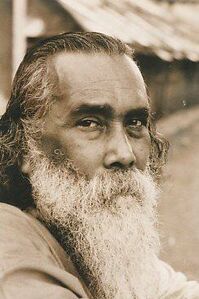Kumar was very close to Subho Tagore. He was the nephew of the Nobel Laureate Rabindranath Tagore. In fact Subho Tagore lived very near the house of Kumars. He had taken residence in Metropolitan Building, at Chowringhee, and he would often take a rickshaw to drop in to Kumars. With his long flowing beard and attire, which was like a flowing robe, he looked more like a seer. He was an artist, thinker, and poet, writer –all rolled in one. He never carried any money and that did not bother the rickshaw puller who brought him to Kumar’s abode. For one day he would pay them many times over and above, which would more than justify the fare and sometimes became the resource for them to visit their relatives at their village. Subho Tagore originally lived at No 6, Jorasanko, which is now known as Maharshi Bhavan. It was then divided into several portions, each belonging to one of the brothers. In Hirendranath's portion of the house Subho Tagore and his two brothers used to reside.
Subho Tagore was the father of Cubism in India, and also a collector and an antiquarian himself. He had a rare collection of letters comprising pieces from Ram Mohan Roy, Vidyasagar and off course Rabindranath Tagore.He was a great connoisseur of art ,He also had a rare collection of inkpots and hookah, some dating back to the Mughal period. He was very keen to build a museum at a place called Janai, near Calcutta.
Subho Tagore was one of the founder members of The Calcutta Group of artists, which came into existence in 1943. This was in response to the famine in Bengal that year which killed thousands of people in the countryside and provoked scenes that shook the conscience of the state. The artists professed humanistic ideals and, in their work, attempted to show their sense of concern in a language that combined the Bengali pictorial idiom with the contemporary modernist manner.
Subho Tagore would spend hours at Kumars just going through books. He was very soft spoken and a man of few words. He would sit in one place, pour over books with his pince-nez hanging from his nose and then very silently he would disappear The only time he would be almost jubilant was in his annual sojourn to Kumars with his family members. Almost taking a pride that he has discovered a treasure in Ali Baba’s Cave. All his family members were connected with arts and they would go about the collection with Subho Tagore, very softly adding the background narration to the importance of the book etc. etc. His own daughter Chitralekha Tagore currently lives in Canada and is an artist by her own right.




